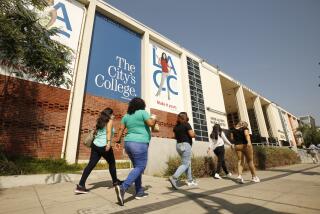Overhaul of ‘Dysfunctional’ Community Colleges Urged
Calling the state’s community colleges “dysfunctional,” a group of prominent Californians on Monday suggested steadily increasing student fees and abolishing college districts and their elected trustees as a way to make each college more responsive and independent.
Besides aiming what one member of the group calls “a missile at the Los Angeles Community College District,” the California Citizens Commission on Higher Education proposed other sweeping changes that it asserts are drastically needed if the state’s colleges are to cope with an expected flood of 500,000 additional students enrolling during the next six years.
The commission’s recommendations have something to offend everyone: a 4.6% increase in fees each year for all public college and university students, putting college administrators on a forced-savings plan during good years to stash away money for lean times and abolishing elected boards that provide steppingstones for aspiring politicians.
Indeed, even as the group issued its report, critics went on the attack, calling its recommendations anti-democratic, even racist.
Others defended the study. The report is “a wake-up call to prepare for the tidal wave of new students,” said Charles Reed, chancellor of the 22-campus California State University system.
The high-profile members of the commission, led by Harold Williams, the former head of the Getty Trust, and John Slaughter, president of Occidental College, plan a major push to ensure that their recommendations do not suffer the fate of most such reports--gathering dust on a shelf.
Among other steps, they will hold hearings around the state, cajole lawmakers into joining them on retreats to pore over the proposals and press candidates for governor to adopt their recommendations.
Although California’s higher education system remains the envy of the nation, Williams said the state’s long-standing promise of an affordable college degree for every state resident is in jeopardy.
“Look at what happens to us in the public school system,” he said. “Suddenly, we woke up one day and said, ‘What happened to our wonderful system?’ The same thing will happen in higher education, unless we make some major changes.”
Perhaps the most controversial proposal in the group’s report, “A State of Learning: California Higher Education in the 21st Century,” is the idea of eliminating the 77-year-old tradition of electing local trustees to run community colleges.
“The commission is quite concerned about the dysfunctional structure and governance system of the California Community Colleges, which needs urgent attention,” the report said. These two-year colleges will have to absorb 75% of the children of the baby boomers, who are about to reach college age.
Electing local boards of trustees--and holding them accountable to the voters--made much more sense when community college districts had the power to raise taxes, said William Pickens, the commission’s executive director. But that all changed in 1978 with the passage of Proposition 13.
The commission suggested replacing the elected officials with an appointed 17-member council at each college, but also giving the statewide chancellor of the community college system the power to oversee each college’s budget and choose its president.
Trustees--who would lose their political base of power--can be counted on to hate the idea.
“How unfortunate it is that when nonwhites are going to be in the majority, this commission would propose taking the vote away,” said David Viar, executive director of the Community College League, which represents college district trustees.
Faculty union leaders, who often hold enormous sway in board elections, loathe the idea of having someone in Sacramento sign off on contract negotiations.
Carl Friedlander, president of the American Federation of Teachers’ College Guild in Los Angeles, said that a locally elected board would be replaced by a “highly political kind of board that would be used by legislators and others for political patronage.”
Even Thomas Nussbaum, chancellor of the statewide community college system, said he favors working to strengthen the relationship between his office and locally elected trustees rather than turning them out. “We are interested in meaningful change, but we want to work with the system we’ve got.”
But at least one trustee said she has often wondered during her three years as a Los Angeles Community College trustee if the locally elected district “is an outmoded concept.”
Gloria Romero characterized running for the board of trustees as “political Siberia,” with few of the five million voters in the district having any clue to what she does or represents.
“Community colleges are in serious disarray,” Romero said. “It’s long overdue to put these kinds of ideas on the table.”
One of the commission’s central themes is to stabilize the roller-coaster state funding of higher education. Currently, the budget for higher education benefits handsomely during the boom years, but then suffers disproportionately during economic busts.
Among other things, the commission recommended that student fees for the University of California, California State and community colleges rise 4.6% every year for the next five years. The size of annual increases would be recalculated after that, in a formula tied to personal income.
Such stability, the commissioners said, would allow students and their families to make realistic plans to cover college expenses. And a steady planned increase would avoid the whopping 100% increases that socked students during the recession of the early 1990s.
The commission also suggested that the Legislature cover financial aid for poor students, allowing public universities to discontinue the practice of “soaking the middle class” by using one-third of student fees to subsidize college costs for the needy.
In addition, the report recommended linking state funds to the number of students who complete courses and degrees. As it works now, community colleges and California State campuses are paid according to a count of students taken in the weeks before the midterm. There is no financial incentive for colleges to keep students from dropping after that period.
An even more controversial idea is to set up a higher education “trust fund,” which would operated like a forced-savings plan for public colleges and universities.
The idea is that the Legislature would put money into a fund during economic good times, so that the schools would have something to fall back on when the economy takes a dive.
“It’s totally unrealistic,” said UC budget chief Larry Hershman.
Such a fund would be the first place the Legislature would raid during a fiscal crisis to pay for prisons or something else, he said.
More to Read
Sign up for Essential California
The most important California stories and recommendations in your inbox every morning.
You may occasionally receive promotional content from the Los Angeles Times.










